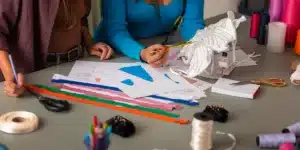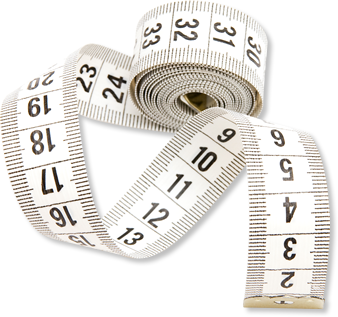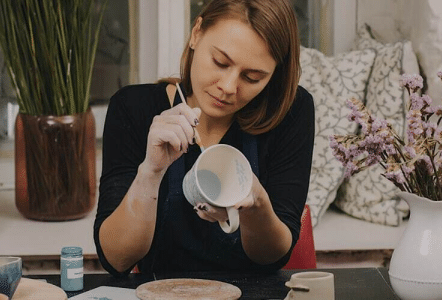Sewing businesses have always been an in-demand service, especially for niche products.
No matter what kind of products you plan on making, if you’re looking to make an income from it, it’s important to have the right plan in place to help your business grow.
Is sewing a profitable business?
Yes, sewing can become an extremely profitable business, especially if you specialise in a niche market or make high-quality products that are on trend.
Focusing on a specific market, such as pet accessories, bridal wear and even home accessories can attract a certain clientele who are willing to pay more for handmade goods.
What do you need to start a sewing business?
To start a sewing business, one thing you will need to develop is a strong sewing skillset. Of course, this is something you will learn along the way, but having a good understanding of how to sew quality items is key to getting your business off the ground.
Sewing business plans
Along with all of your physical materials, you will also need a business plan to help you focus on the specific steps your business needs to follow in order to thrive.
Your business plan should include the following information:
- Your company information
- A description of your company
- The services and products you will provide
- Your branding, including your brand ethos and tone of voice
- A marketing plan
- The structure of your business
- The operational plan of your business
- The financial plan and projections of your business

Costs of starting a sewing business from home
There are a few different costs that you can expect to see when you start your at-home sewing business.
Some of the primary costs of starting a sewing business include:
- Sewing machine and related materials, such as threads, needles and fabrics
- Marketing and branding costs, such as advertising and paying for a designer to build your brand logos and branded assets
- Packaging and postage costs
- Social media advertising fees
- Potential alterations to your home, such as building a home studio or renovating a room as a studio
- Further education and courses if you wish to expand your skillset or learn new techniques
It’s worth bearing in mind that these costs will vary from business to business depending on what types of fabrics you use, where you get your supplies from and where you are located.
Protect your Small Business with Insurance
Legal requirements of starting a sewing business
There are a few different legal elements you will need to consider when starting your sewing business.
Tax
You must register your sewing business with HMRC if you are self-employed. Thankfully, this is quite simple and straightforward to do.
HMRC do have a trading threshold of £1000, meaning you may not need to fill in a self assessment form if your first year is under this threshold. However, HMRC notoriously cracks down on small businesses for not correctly reporting their earnings, and so we highly recommend registering even if you have not reached the threshold.
Insurance
Although insurance isn’t an actual legal requirement in the UK, it is essential for protecting yourself and your business if a claim is made against you.
At CraftCover, our bespoke sewing business insurance allows crafters to protect their goods, equipment and business from losses due to damages, accidents or claims. Without the right insurance in place, your sewing business could suffer severely from expensive claims.
Our insurance includes two of the most important insurance types:
- Public Liability Insurance – covers the cost of claims made against your business by members of the public if an incident occurs due to your businesses activities. It provides legal liability for injury or death to the public and for loss or damage to property.
- Product Liability Insurance – covers you and your business if a customer has an issue with the production, sale and supply of your products. This also includes any repair, service or maintenance works you may undertake.
Safety measures
Depending on what products you are making and the materials you use, you should always check what safety standards need to be met.
For example, your products must be labelled in accordance with the specific rules for the product type. You can find out more on these labels by heading over to UKFT, which outlines the rules in regards to care labels, environmental labelling and flammability.

Marketing your sewing business
There are a few different ways you can market your sewing business. Social media is quickly becoming one of the best ways to market your business, especially with the likes of TikTok and Instagram. They can also become invaluable tools when it comes to building a community and encouraging repeat customers.
You can also market your business through methods such as business cards, posters and flyers. Many cafes within cities are more than happy to help other local businesses by having pinboards for business cards and flyers to go.
Selling your hand sewn crafts
There are a wide number of places you can sell your hand sewn crafts, most of which are really user friendly and easy to set-up.
Popular craft selling sites include:
- Etsy
- Folksy
- Facebook Marketplace
- Depop
- Ebay
However, it’s worth keeping in mind that some sites will charge a sellers fee or take a percentage of your sales, which can be costly if you are just starting out.
If you wish to sell your products in person, you could attend local craft fairs and markets. There are a wide variety of different markets all across the UK so finding one that is right for you shouldn’t be an issue. We can help by providing craft fair insurance in your annual policy, or even one-off craft fair insurance if you don’t want to fully commit to a year’s worth of craft fair insurance.



